The Roosevelt dime is among the most popular coins in the United States. Thousands of Roosevelt dimes are issued yearly, and the 1952 dime was only one of them.
Since the 1952 dime has been struck for more than 70 years and is made of silver, many people are interested in adding this coin to their collection.
Are you one of them? If yes, then you would surely be happy to read the rest of this article.
What Is the 1952 Roosevelt Dime Made Of?
The 1952 Roosevelt dime is made of 90% silver and 10% copper. It has a value of 10 cents, a mass of 2.50 grams, a diameter of 17.91 millimeters, and a reeded edge.
The Roosevelt dime was made of silver from when it was first struck until 1964. From 1965, the US Mint produced cupro-nickel dimes free of precious metals such as silver. However, there are collectors’ versions of the Roosevelt dimes that are still made of silver.
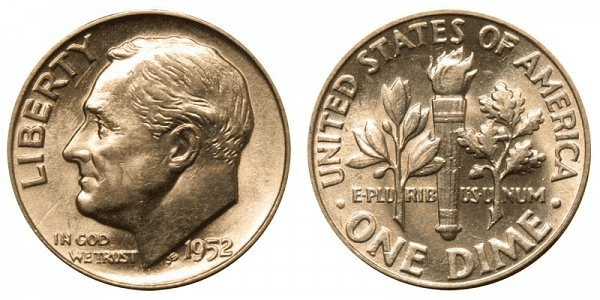
The 1952 Dime features an image of Franklin D. Roosevelt, the 32nd president of the United States. He is one of the most popular US presidents to the point that immediately after he died in 1945, it was decided that his image would be seen on the 10-cent coin.
From 1946 to the present day, the design of John Sinnock was used for the dime — both the obverse and reverse sides of the coin.
As mentioned, the obverse features the face of Roosevelt, while on the reverse, you’ll find the images of an olive branch, oak branch, and Liberty torch.
1952 Roosevelt Dime Varieties
The 1952 Roosevelt dime comes with four standard varieties. These are the following:
| Variety | Mint Location | Mintage |
| 1952 D Roosevelt Dime | Denver | 122,100,000 |
| 1952 S Roosevelt Dime | San Francisco | 44,419,500 |
| 1952 P Roosevelt Dime | Philadelphia | 99,040,093 |
| 1952 Proof Roosevelt Dime | Philadelphia | 81,980 |
| Total | 265,641,573 |
In 1952, the combined effort of the three mint centers led to the production of more than 265 million dimes. This is a huge jump compared to the 1951 dime mintage. Even in 1953, the mint centers produced fewer dimes.
Let’s not look deeper at each of the 1952 Roosevelt dimes.
1952 D Roosevelt Dime
Year of minting: 1952
Mint Mark: D
Place of minting: Denver
Quantity produced: 122,100,000
Face Value: $0.10 (ten cents)
Price: $2.10 to $2.60 (circulated condition)
Mass: 2.50 grams
Edge: Reeded
Designer: John R. Sinnock
Composition: 90% Silver and 10% Copper
Diameter: 17.90 millimeters
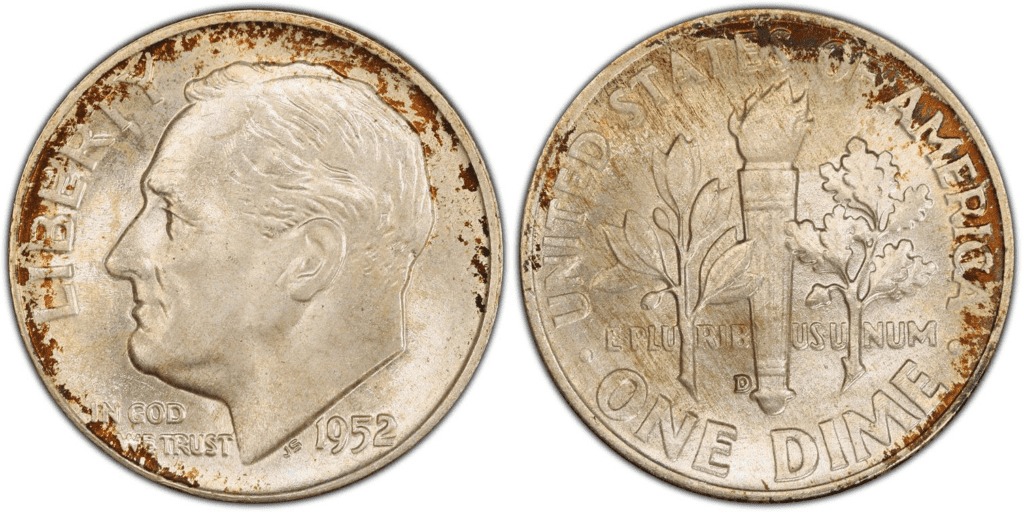
The Denver Mint produced the most 1952 dimes reaching up to 122.1 million. Since this is an old coin, a 1952 dime can be worth around $2.10 to $2.60.
The United States economy was on its way to recovery after years of financial difficulties. That’s why the Denver Mint produced twice as many dimes as the previous year.
1952 S Roosevelt Dime
Year of minting: 1952
Mint Mark: S
Place of minting: San Francisco
Quantity produced: 44,419,500
Face Value: $0.10 (ten cents)
Price: $2.10 to $2.60 (circulated condition)
Mass: 2.50 grams
Edge: Reeded
Designer: John R. Sinnock
Composition: 90% Silver and 10% Copper
Diameter: 17.90 millimeters
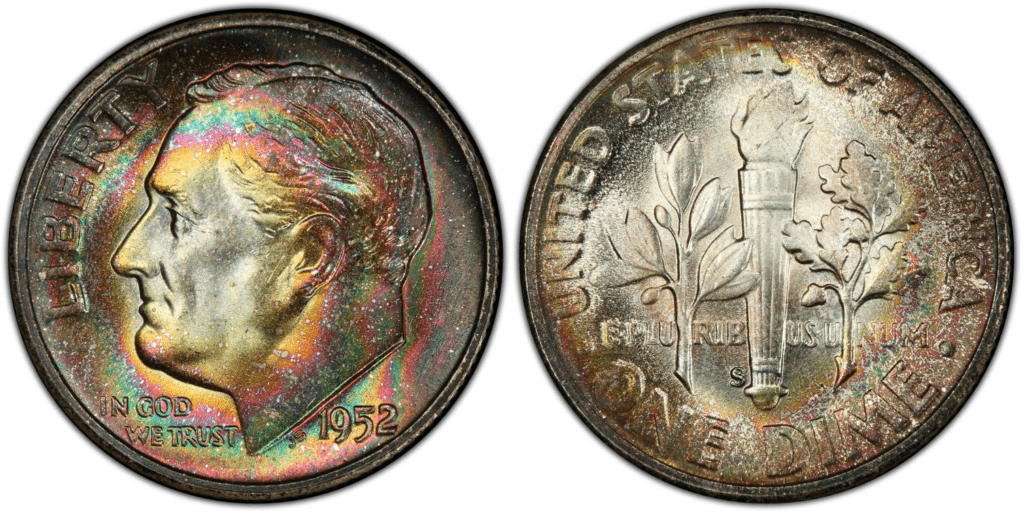
The San Francisco Mint contributed more than 44 million dimes to circulation in 1952, and this is one of the highest mintages of Roosevelt dimes from this particular mint center. Collectors would also be happy to know that plenty of the MS-67 graded 1952-S dimes exist today.
1952 P Roosevelt Dime
Year of minting: 1952
Mint Mark: none
Place of minting: Philadelphia
Quantity produced: 99,040,093
Face Value: $0.10 (ten cents)
Price: $2.10 to $2.60 (circulated condition)
Mass: 2.50 grams
Edge: Reeded
Designer: John R. Sinnock
Composition: 90% Silver and 10% Copper
Diameter: 17.90 millimeters
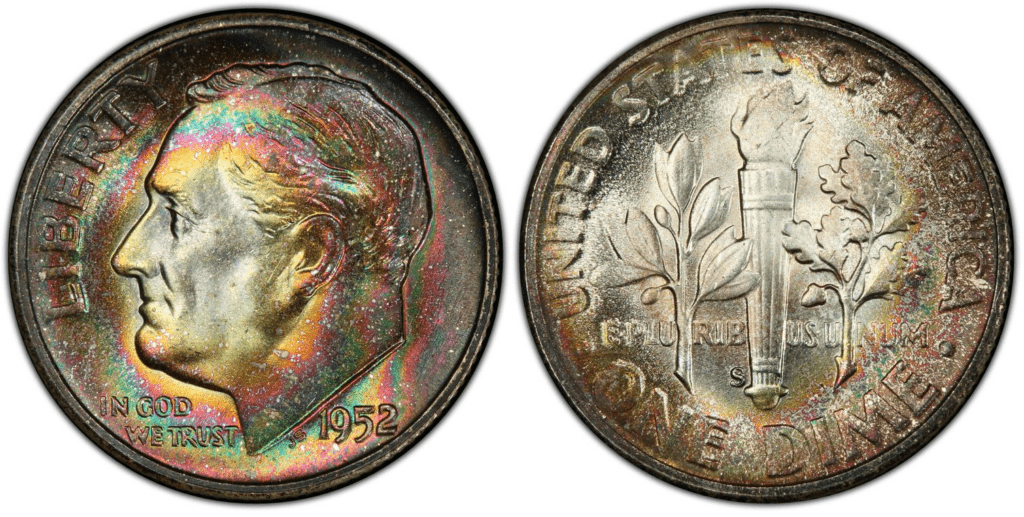
The Philadelphia Mint produced almost 100 million dimes in 1952. You should be able to find 1052-P dimes at an affordable price but be ready to pay more for dimes in uncirculated condition.
1952 Proof Roosevelt Dime
Year of minting: 1952
Mint Mark: none
Place of minting: Philadelphia
Quantity produced: 81,980
Face Value: $0.10 (ten cents)
Price: $16 or more (uncirculated condition)
Mass: 2.50 grams
Edge: Reeded
Designer: John R. Sinnock
Composition: 90% Silver and 10% Copper
Diameter: 17.90 millimeters
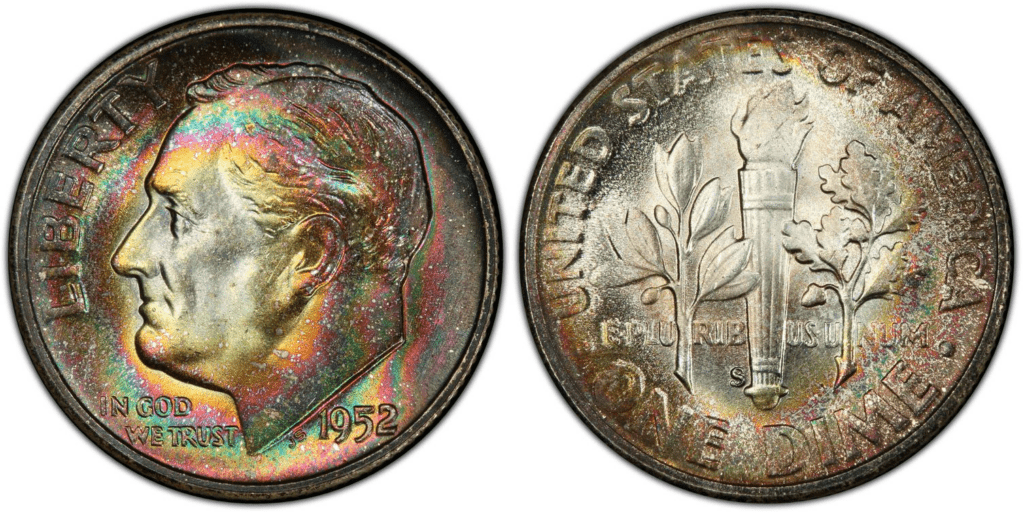
The Philadelphia Mint produced proof dime coins for collectors. Proof coins are more detailed and beautiful in appearance. They are manually polished and wiped to produce the highest level of luster.
List Of 1952 Roosevelt Dime Errors
Like any other US coin series, an error coin is always expected to appear. While the US Mint doesn’t like error coins to happen, it is something that many collectors look forward to. Many people would like to add unique dimes to their collection, and error dime coins could be a great addition.
These are some of the 1952 Roosevelt Dime errors:
Repunched mintmark
The most common error for the 1952 dime would be the repunched mintmark. This happens when the mintmark is punched on the planchet twice. Sometimes, even more than that.
Repunched mintmarks (RPM) can be found in dimes produced in San Francisco, although some come from Denver.
Here’s an example of a 1952 Roosevelt dime with an RPM error:
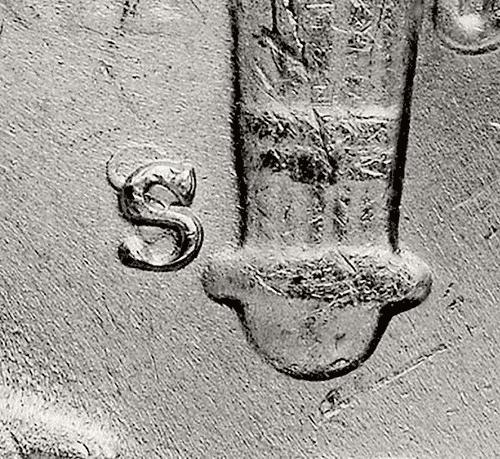
Die break
Due to multiple strikes, the die could eventually break. Because of that, the die’s surface will develop cracks, and when a broken die hits the planchet, these cracks can also be impressed on the planchet. Die breaks can manifest themselves as small and short lines.
Doubled die
When the die hits the planchet twice, it creates the doubled die error. A coin with a doubled die error would have some doubling appearance, particularly on the letters and numbers. Most doubled die errors are not prominent. They can’t be readily seen. However, finding a 1952 dime with an obvious doubled die error can be very valuable.
How Much Is 1952 Roosevelt Dime Worth Today?
The 1952 Roosevelt dime has a face value of 10 cents. However, since this is made of silver, it has a higher melt value, around $1.5994. This value can increase or decrease depending on the market value of silver.
Moreover, if you plan to buy a circulated 1952 Roosevelt dime, the price may be below $2 to $3.
As you can see, the ordinary 1952 Roosevelt dimes aren’t that valuable. Nevertheless, 1952 dimes are astronomically more valuable than their face or melt value.
You can check out this table and see the auction records for each variety:
| Coin | Condition | Grade | Sold date | Sold by | Value |
| 1952 Proof Roosevelt Dime | Superb Gem Uncirculated | PR 68 – Cameo | January 1, 2007 | Heritage Auctions | $4,313 |
| 1952 S Roosevelt Dime | Superb Gem Uncirculated
|
MS 68 (Full Band) | October 8, 2014 | Heritage Auctions | $3,290 |
| 1952 D Roosevelt Dime | Superb Gem Uncirculated | MS 67+ (Full Band) | March 1, 2015 | Heritage Auctions | $2,703 |
| 1952 P Roosevelt Dime | Superb Gem Uncirculated | MS 67 (Full Band) | November 6, 2007 | Heritage Auctions | $1,093 |
How Does The Grading System Work?
The 1952 dime is graded using the Sheldon Scale with a 70-point grading system. The appraiser would look into the color, luster, strike, and preservation of the 1952 dime and then give it a numerical grade from there.
Professional numismatists joined in the 1970s and established CoinGrading standards, known as the Sheldon Scale. These numismatists now assign grades at key places on the seventy-point scale, using the most regularly utilized numeric points in conjunction with the original adjective grade. The following are the most common coin grades:
- (P-1) Poor – Indistinguishable and probably damaged; if used, must have a date and mintmark; otherwise, rather battered.
- (FR-2) Fair – Nearly smooth, but without the damage that a coin graded Poor often possesses. The coin must have enough detail to be identified.
- (G-4) Fair – Inscriptions have merged into the rims in some areas, and important elements have been mostly erased.
- (VG-8) Very Good- A little weathered, but all primary design elements are visible, albeit faintly. There is little, if any, central detail left.
- (F-12) Good – The item is very worn, yet the wear is even, and the overall design details stand out clearly. Rims are almost completely isolated from the field.
- (VF-20) Very Fine – Moderately weathered, with some finer features still visible. The motto or all letters of LIBERTY are readable. Both sides of the coin have entire rims separated from the field.
- (EF-40) Extremely Fine – Gently used; all gadgets are visible, and the most important ones are bold. The finer details are bold and clear; however, light wear may be seen.
- (AU-50) Uncirculated – Slight evidence of wear on the coin’s design’s high points; it may have contact marks; eye appeal should be adequate.
- (AU-58) Uncirculated Choice – Slight traces of wear, no severe contact marks, almost full mint shine, and great eye appeal.
- (MS-60) Mint State Basal – Strictly uncirculated; no indication of wear on the coin’s highest points, but an unsightly coin with reduced luster, visible contact marks, hairlines, and other flaws.
- (MS-63) Mint State Acceptable – Uncirculated, but with contact scratches and nicks, little reduced shine, but otherwise appealing appearance. The strike is weak to average.
- (MS-65) Mint State Choice – Uncirculated with great mint shine, little contact blemishes, and exceptional eye appeal. The strike is unusually severe.
- (MS-68) Mint State Premium Quality – Uncirculated with superb luster, no obvious contact marks to the naked eye, and exceptional eye appeal. The strike is quick and appealing.
- (MS-69) Almost Perfect Mint State – Uncirculated with perfect brilliance, a sharp and appealing strike, and extremely good eye appeal. A near-perfect coin with minor imperfections in the planchet, strike, and contact markings (seen only under 8x magnification).
- (MS-70) Mint State Perfect – Under 8x magnification, no tiny imperfections are discernible; the strike is crisp, and the coin is perfectly centered on a beautiful planchet. Rarely seen on a coin, this coin is bright and whole, with original luster and exceptional eye appeal.
Aside from the Sheldon Scale, the Roosevelt dime has a special grade designation. A dime with a detailed horizontal band on the Liberty torch would be categorized as Full Bands. Dimes with a Full Bands category mean it is in good condition and has a better strike and higher value.
Where To Buy Or Sell 1952 Roosevelt Dime?
The 1952 Roosevelt Dime is available online. You can find your chosen coins directly on Amazon, eBay, and Etsy. Aside from that, a simple Google search should help you find websites and sources that should help you buy and sell Roosevelt dimes.
Using the Internet gives you an easy and quick way to transact online. However, be sure to only transact with trusted entities since the Internet can be full of scammers.
You can try coin shops and antique stores near you if you want. They might have 1952 Roosevelt dimes. Contact PCGS since they also have authorized dealers that would help you.
FAQs
Is a 1952 dime silver?
Yes, the 1952 dime is made of silver. Specifically, it is made of 90% silver and 10% copper.
What makes a 1952 dime rare?
The 1952 dime is an old coin. Because of that, it couldn’t easily be found in circulation today. Nevertheless, it is rare when it is still in good condition, received a high grade from appraisers, and possesses unique attributes.
Where is the mint mark on a 1952 dime?
The mint mark on a 1952 dime is found on the coin’s reverse side. It should be found on the left side at the lower tip of the Liberty torch.
1951 Roosevelt Dime Value Guide
1951 Jefferson Nickel Value Guide
1952 Franklin Half Dollar Value Guide
1952 Wheat Penny Value Guide
1953 Jefferson Nickel Value Guide
1953 Wheat Penny Value Guide
